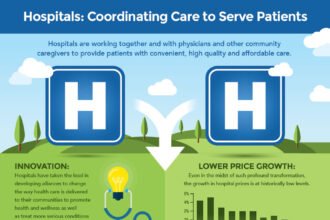So an anthropologist walks into a doctor’s office… No, this is not the set up to a joke. Instead, it’s the start of an intensive process that provider groups and hospitals can use to understand the patient experience in depth. It offers powerful tools to identify gaps that lead to lower satisfaction or engagement, and thereby spot improvement opportunities. Using fieldwork techniques from anthropology sheds light on what’s working and what’s not in ways that are hard to replicate either by making assumptions or by traditional patient satisfaction surveys.
So an anthropologist walks into a doctor’s office… No, this is not the set up to a joke. Instead, it’s the start of an intensive process that provider groups and hospitals can use to understand the patient experience in depth. It offers powerful tools to identify gaps that lead to lower satisfaction or engagement, and thereby spot improvement opportunities. Using fieldwork techniques from anthropology sheds light on what’s working and what’s not in ways that are hard to replicate either by making assumptions or by traditional patient satisfaction surveys.
Here are three such techniques you can use to develop a nuanced picture of the patient experience at the point of care and bring clues to the surface for how to make it better:
1. Behavioral surveys:
Surveys are familiar to most providers and patients, but, as the saying goes, familiarity breeds contempt. They have a bad reputation not because they are unhelpful, but because patients are accustomed to hearing the same sorts of questions time after time, from business after business. Worse, they give feedback again and again, only to have the same experience the next time they interact with you. So, break the contempt factor of questions about attitude that you never actually act on by asking better questions instead, before and after the patient visit:
Sample Pre-Visit Survey Questions
• How long do you expect to wait in the waiting area? In the exam room?
• How much time do you expect to spend with your doctor?
• What do you expect your doctor to say and do?
(Note: Be careful to reassure them they need not discuss any specifics of their condition or reason for visiting. Use checkboxes to describe types of interaction instead).
Sample Post-Visit Survey Questions
• How long did you wait in the waiting area?
• How much time did you spend with your doctor? In the exam room?
• What did your doctor say and do?
• What do you expect as a follow up from this visit? What will you do and what should we do?
(Note: Again, use checkboxes to describe types of interaction rather than clinical questions.)
This type of survey instrument allows you to compare expectations and experience in a much more concrete way than generic satisfaction or “would you recommend?” questions. Keep it to between five and seven questions per patient.
Most important, however, is that they give you an immediate opportunity to identify post-visit expectations. If you ask this question, make sure you follow through on any reasonable requests. Your follow-through will make an enormous impact on how they perceive their experience.
2. Participant Observation
Have you ever really sat down and tried “people watching” in your offices? You would be surprised how much you can learn. On the surface, the technique is simple. You need do no more than place a normally-dressed staff member in a waiting area, and watch how people interact. Spend an hour or two at reception taking copious notes about what people do while they wait to sign in, how they are greeted, how they interact with staff, what they do, how they respond when given forms to fill out, etc. Then spend an hour or two with a vantage point on the whole waiting area and observe people discretely. Take notes on how long they are there, what they do while waiting, whether they pay attention to any patient education materials you have displayed, and their emotional demeanor.
To structure the process, start with a basic framework of what you want to find out, and follow specific individuals in your observations. Track them by gender and age bracket, and by whether they are alone or with a caregiver or children, but for the sake of patient privacy, do not connect the dots by linking your notes to actual names.
With the resulting notes, you can carry out an analysis that leads to specific improvements and interventions at each point of their journey from entering the office to being seen. You’ll better understand what they are doing, how they are responding, and where your opportunities to capture their attention might be. You may find that people look at brochures but only when they are within a few feet. You may find that people focus on wall screens where you could also display practice information and wellness tips. You may find that people fidget with their phones and might be receptive to downloading an app that you offer. These are just a few potential findings. This technique uses direct observation and inference to open a wide spectrum of opportunities to connect, communicate, and engage.
3. Patient Shadowing
This technique requires a narrow scope, careful planning, and a high level of trust with your patients. But you can in fact do “play-by-play” observation of patients, with their explicit permission, through at least some parts of the patient journey. Think of these interactions as a 3-D, full color version of your 2-D, black-and-white patient survey instruments.
With patient shadowing, you explicitly invite patients to participate. During your shadowing, you ask a predefined set of questions, but instead of putting the answers on a quantitative scale, you probe for detail, and you include your own observations. For example, ask patients if they would be willing to have someone sit with them in the waiting room to ask questions about their experience. Always, of course, reassure them that the questions do not relate to their condition and will never be tied to their names or medical records. Or, you can carry out similar inquiry as they go from the waiting room to the exam room, or again when they are checking out and/or paying.
You can also use this technique very effectively in the context of a patient portal rollout. Ask unenrolled patients if they would be willing to work with a facilitator to sign up for the portal at a kiosk in the office, and then observe them as they start from your website or from your patient-facing portal materials. You can let them work more or less unaided, observing where they struggle, and listening to any questions or concerns they have. Or, ask enrolled patients to log on with you, and observe how smooth or rough the experience is for them. What you learn will help you improve the usability of your portal and the usefulness of your communication materials.
So to wrap it up, with these three techniques, when an anthropologist walks into a doctors office, here’s what happens. You learn the realities of your current patient with a high level of diagnostic richness and depth. You gather the raw data and material needed for a strong analysis of what’s working, what’s not working, and what you can do at every step of the patient journey, in order to deliver a top-notch, engaging patient experience.
The post Three Research Techniques For Patient Experience Breakthroughs appeared first on Syncresis.







